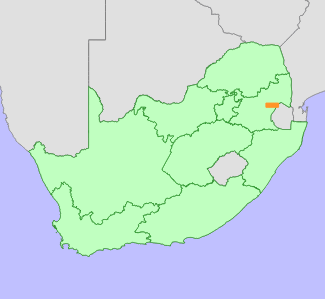Aloe thorncroftii has a restricted distribution range, and is localized to a few serpentine outcrops in the Barberton Mountains. According to Williamson and Balkwill (2006), the population is small, consisting of between 1500 and 3000 mature individuals, and there are between four and seven subpopulations. The population is not suspected to be declining at present, but due to its localized distribution, potential threatening events such as expansion of mines or plantations, could rapidly increase its risk of extinction.
|
Hall, A.V., De Winter, M., De Winter, B. and Van Oosterhout, S.A.M. 1980. Threatened plants of southern Africa. South African National Scienctific Programmes Report 45. CSIR, Pretoria.
Hilton-Taylor, C. 1996. Red data list of southern African plants. Strelitzia 4. South African National Botanical Institute, Pretoria.
Raimondo, D., von Staden, L., Foden, W., Victor, J.E., Helme, N.A., Turner, R.C., Kamundi, D.A. and Manyama, P.A. 2009. Red List of South African Plants. Strelitzia 25. South African National Biodiversity Institute, Pretoria.
Smith, G.F., Steyn, E.M.A., Victor, J.E., Crouch, N.R., Golding, J.S. and Hilton-Taylor, C. 2000. Aloaceae: The conservation status of Aloe in South Africa: an updated synopsis. Bothalia 30(2):206-211.
Van Wyk, B.-E. and Smith, G.F. 2014. Guide to the Aloes of South Africa. (Third ed.). Briza Publications, Pretoria.
Victor, J.E. 2002. South Africa. In: J.S. Golding (ed), Southern African plant Red Data Lists. Southern African Botanical Diversity Network Report 14 (pp. 93-120), SABONET, Pretoria.
Williamson, S.D. and Balkwill, K. 2006. Factors determining levels of threat to serpentine endemics. South African Journal of Botany 72(4):619-626.
|
 Comment on this assessment
Comment on this assessment


